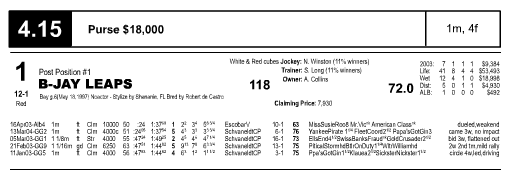Horse Racing Form
A horse race form is a printed program containing details about a horse race meeting. It usually lists the scheduled races, the names of the horses, and other pertinent race information. A horse race card helps bettors make an informed betting choice.

Time
The race's starting time.
Purse
The purse is the prize money that is split between the owner, trainer and jockey and possibly others in the winning group. Prize money is also distributed, on a sliding scale, to those finishing in the first few places.
Distance
Flat races are usually run at distances from 5 to 12 furlongs. A furlong is one eighth of a mile or 0.2 km.
Program Number
This is the race number.
Morning Line Odds
The horse's odds at the start of the day. This changes as the day progresses and more bets are placed.
Saddle Cloth Color
This is included to help the spectators and bettors identify their horses at a distance.
Post Position
The position assigned to the horse in the starting gate.
Horse Name
Owners often use a name that stands out and is easily recalled by bettors. This is done since the horse's name is often used by many neophyte bettors to select their bet.
Horse Color
The major colors are bay, chestnut, black, brown, white, gray, pinto (patches of brown, white and black), buckskin, dun, and roan.
Sex
Contains an abbreviation of the horse's sex.
- c - colt
- f- filly
- h -thoroughbred aged 5 or older
- gelding
Age
All horses count January 1 as their birth date. Individual horses mature at different ages. Most horses reach mental maturity at around seven or eight years old, when their behavior generally becomes calmer and more accepting.
Sire and Dam
The names of the horse's parents. The dam's sire is often included. This data is useful for bettors to determine possible horse performance through lineage.
Breeder
The person who handled the horse's upbringing.
Weight
The amount of weight, including the jockey, which the horse will carry. Many jockeys are on strict diets so they can 'make the weight' for their rides.
Claiming Price
The Claiming Price is the price at which the horse is available for sale to a qualified buyer. As not all horses are competitors in stakes level races, racing in the claiming ranks gives the opportunity to race against horses of similar caliber. Thus, for example, when a horse easily wins against $5,000 claimers, he may be moved up in value to avoid his being claimed. More prominent tracks would generally feature horses of higher value. Claiming Prices vary from $5,000 to $150,000 depending on the track.
Trainer
The trainer is responsible for getting the horse in perfect shape for race day.
Owner
The owner pays for a horse's training, and is eager to receive a return on his investments.
Jockey
The rider has a massive part to play in a big race. His ability to guide the horse in the race often spells the difference between victory and defeat.
Jockey's Silks
The rider's silks differentiate one mount from another, and are crucial to viewers who want to distinguish which horse they have backed. The variations can include spots, hoops, stars and stripes. A more recent innovation is the use of a sponsors' logo.
Summary of Results
This section includes a breakdown of the horse's racing results during the current year, during his lifetime, under wet track conditions, on the same distance and on the same track. It also lists the horse's previous earnings.
It also contains the horse class rating which is a mark that is based on the horse's speed in previous races, with emphasis placed on recent performance and races run at today's distance. It's usually a number between 50.0 and 100.0.
Summary of Races and Performance
This section is usually found on the lower portion of a horse's slot on a racecard and contains a performance summary of the horse's most recent races. It includes the following:
- Date, track and race number
- Race Distance - expressed in terms of miles and furlongs
- Track Condition - tracks may be wet fast (wf), fast (ft), good (gd), slow sl), wet slow (ws), rain affected (ra) and others
- Type of Race - races may be maiden race (Mdn), starter race (Str), claiming race (Clm), allowance race (Alw), or stakes race (Stk).
- Purse Amount - the race prize
- Pace Figure - a speed rating averaged over several points of call
- Points of Call - horse times, positions and distance from the leader at the First Call, Second Call, Third Call and Stretch Call
- Final Position - the horse's position at the finish; the number usually contains a whole number and a mixed numeral -- the whole number denotes the horse's order of finish while the mixed numeral denotes the measurement of lengths behind the winner
- Jockey's name - the jockey that rode the horse in the race
- Final Odds - the horse's odds at the start of the race
- Speed Figure - this is a comparison of the horse's time with the best time at the distance at that track in the last three years
- Company Line - the first, second and third-place horses in the race and the margins separating each one
- Comments - the horse's performance as written by a chart caller; the highlights are on the trouble encountered in the race and how he finished
